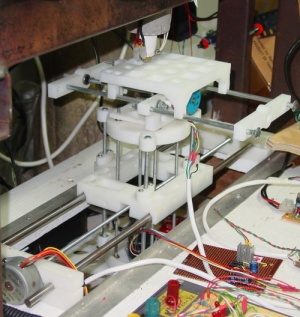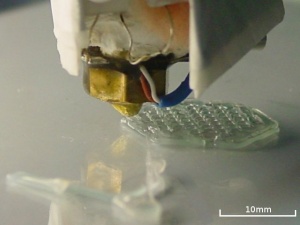Difference between revisions of "Additive manufacturing"
(→RepRap) |
|||
| Line 17: | Line 17: | ||
[[Image:RepRap 0.1 prototype.jpg|thumb|RepRap 0.1 prototype (created by Vik Olliver)]] | [[Image:RepRap 0.1 prototype.jpg|thumb|RepRap 0.1 prototype (created by Vik Olliver)]] | ||
[[Image:Extrusion of hexagon 2nd layer closeup.jpg|thumb|RepRap 0.1 building an object]] | [[Image:Extrusion of hexagon 2nd layer closeup.jpg|thumb|RepRap 0.1 building an object]] | ||
| − | RepRap is rather special | + | RepRap is rather special prototyping machine. The name is short for '''rep'''licating '''rap'''id prototyper. It is a project started at the University of Bath, UK by Dr. Adrian Bowyer, a Senior Lecturer in mechanical engineering. |
The idea is to create a rapid prototyping machine that, as well as being able to construct useful three dimmensional objects to order, is also able to create all the parts necessary to build another rapid prototyping machine. So for a very low cost, someone with a RepRap should be able to clone a new machine to give to someone else. | The idea is to create a rapid prototyping machine that, as well as being able to construct useful three dimmensional objects to order, is also able to create all the parts necessary to build another rapid prototyping machine. So for a very low cost, someone with a RepRap should be able to clone a new machine to give to someone else. | ||
| − | It uses the Fused Deposition Modelling (FDM) system of additive construction where a thermoplastic material is extruded very thinly from a computer controlled nozzle to slowly build up a three dimmensional shape layer by layer. | + | It uses the Fused Deposition Modelling (FDM)[http://en.wikipedia.org/wiki/Fused_deposition_modeling] system of additive construction where a thermoplastic material is extruded very thinly from a computer controlled nozzle to slowly build up a three dimmensional shape layer by layer. |
| − | However there are various parts that it cannot currently reproduce such as the stepper motor, microcontroller, extrusion nozzle and lubricant. However over time as the design evolves and becomes more sophistacated it is envisioned that there will be | + | However there are various of its own component parts that it cannot currently reproduce such as the stepper motor, microcontroller, extrusion nozzle and lubricant. However over time as the design evolves and becomes more sophistacated it is envisioned that there will be fewer and fewer parts that cannot be made by the machine itself. |
| − | When I last saw Adrian he said he was planning on incorporating four extruder nozzles into the machine, each applying a different material | + | When I last saw Adrian he said he was planning on incorporating four extruder nozzles into the machine, each applying a different material: |
| − | + | # A thermoplastic to creates the structure of the object being made. | |
| + | # Wood's metal[http://en.wikipedia.org/wiki/Wood%27s_metal] which is a low melting point metal alloy used to create electrical circuits within the object | ||
| + | # Silicone polymer used for seals and gaskets | ||
| + | # Icing sugar for temporary supports to support overhangs as the object is being built up. After the object is created these supports are easy to dissolve away using warm water | ||
This is an [[Open design]] project in that everything relating to it - i.e. the plans, the 3D CAD models of the components and the software to run it are being released under the GPL license[http://en.wikipedia.org/wiki/GNU_General_Public_License] which enables anyone to use, customize and evolve it. The terms of the GPL also mean that any improvements should likewise be available under the GPL for other s to benefit from. | This is an [[Open design]] project in that everything relating to it - i.e. the plans, the 3D CAD models of the components and the software to run it are being released under the GPL license[http://en.wikipedia.org/wiki/GNU_General_Public_License] which enables anyone to use, customize and evolve it. The terms of the GPL also mean that any improvements should likewise be available under the GPL for other s to benefit from. | ||
| − | http://en.wikipedia.org/wiki/RepRap_Project | + | ===External links=== |
| + | *http://en.wikipedia.org/wiki/RepRap_Project | ||
| + | *[http://www.reprap.org RepRap project website] | ||
{{pagebgend}} | {{pagebgend}} | ||
Revision as of 00:59, 21 September 2006
|

